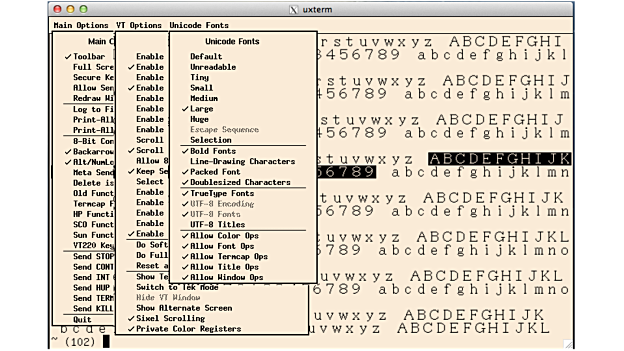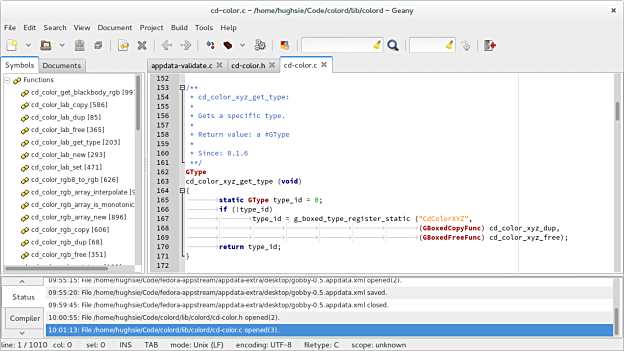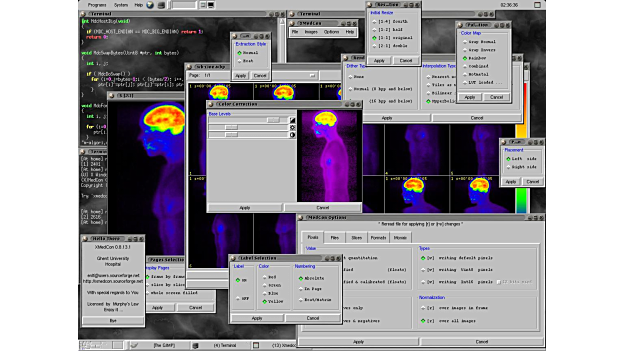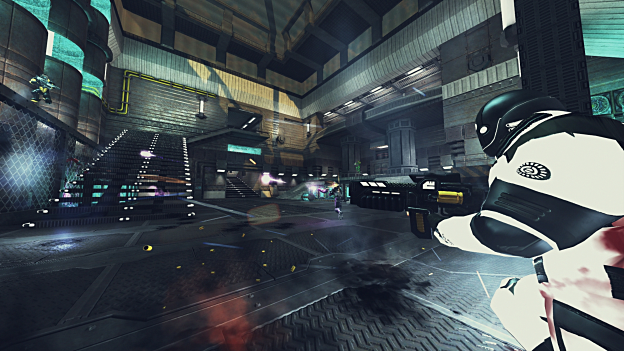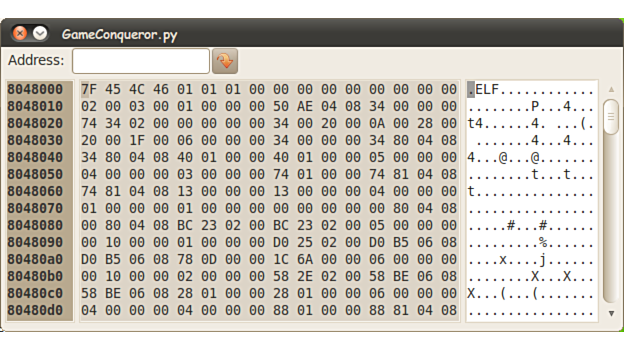5 Metadata Quickstart #
These pages are designed to give upstream authors compressed information on how to write metadata for their applications. The documents describe just the basic information, and don't resemble the whole specification, to give upstreams an easy way to get started with AppStream.
5.1 For GUI application upstream maintainers #
5.1.1 Introduction #
Every software center that exists allows the user to look at screenshots and a long description of the application before it is installed. For most users it allows them to answer the question “Do I want to install this application?”. Traditionally in Linux distributions, we have none of this data for the vast majority of our desktop user-installable applications. The packages-descriptions are describing all contents of a package, and not just a single application. They are also often written in a technical language and refer to other packages, which makes it hard for beginners to understand what the application they want to install really does. Additionally, if you are not using Debian or Ubuntu, the package descriptions are often untranslated. Also, packages do not provide some metadata users might be interested in before installing an application.
To solve this, we have defined a new data file, which the upstream project can optionally translate using the same technique as Desktop Entry files (https://specifications.freedesktop.org/desktop-entry-spec/latest/) or GSetting schemas. The application metainfo specification is a subset of the AppStream metadata (see Section 3.1, “AppStream Catalog XML”) and extends the generic component metadata with fields specific for applications (see Section 2.1, “Generic Component”).
The application-metainfo files override any values which are automatically fetched by the AppStream data generator.
Applications can ship one or more files in /usr/share/metainfo/%{id}.metainfo.xml.
Application metainfo files can - just like all other metainfo files - be translated. See the section about translation for more information about that.
Note
All tags defined in the generic component specification are valid for components of type desktop-application as well,
an application is just defined as a specialized component, which has the additional benefit of being displayed in a software-center application.
Tip
To get you started quickly, the AppStream project provides a web-based form to quickly generate valid metainfo XML for some of the most common use cases. Check it out on freedesktop.org/software/appstream/metainfocreator (https://www.freedesktop.org/software/appstream/metainfocreator/#/).
5.1.2 Example file #
The file should contain something like this:
<?xml version="1.0" encoding="UTF-8"?>
<!-- Copyright 2013 First Lastname <your@email.com> -->
<component type="desktop-application">
<id>org.gnome.gnome-power-statistics</id>
<metadata_license>FSFAP</metadata_license>
<project_license>GPL-2.0+</project_license>
<name>Power Statistics</name>
<summary>Observe power management</summary>
<description>
<p>
Power Statistics is a program used to view historical and current battery
information and will show programs running on your computer using power.
</p>
<p>Example list:</p>
<ul>
<li>First item</li>
<li>Second item</li>
</ul>
<p>
You probably only need to install this application if you are having problems
with your laptop battery, or are trying to work out what programs are using
significant amounts of power.
</p>
</description>
<launchable type="desktop-id">org.gnome.gnome-power-statistics.desktop</launchable>
<screenshots>
<screenshot type="default">
<caption>The options dialog</caption>
<image>http://www.hughsie.com/en_US/main.png</image>
</screenshot>
<screenshot>
<image>http://www.hughsie.com/en_US/preferences.png</image>
</screenshot>
</screenshots>
<url type="homepage">http://www.gnome.org/projects/en_US/gnome-power-manager</url>
<project_group>GNOME</project_group>
<provides>
<binary>gnome-power-statistics</binary>
</provides>
<releases>
<release version="3.12.2" date="2013-04-12">
<description>
<p>Fixes issues X, Y and Z</p>
</description>
</release>
</releases>
</component>5.1.3 Recommended metadata file contents #
This is a list of tags you might want to define for your application. For a full list of all possible tags, take a look at the definition of a generic component (Section 2.1.3, “XML Specification”) and an application-component (Section 2.3.2, “File specification”).
- <id/>
The
<id/>tag value contains the unique identifier for this application. It is usually modeled after the .desktop filename and follows a reverse-DNS scheme. For the full naming guidelines see <id/>.Example: If your application's
.desktopfile is namedorg.example.FooBar.desktop, a good component-id would beorg.example.FooBar.- <metadata_license/>
The
<metadata_license/>tag is indicating the content license that you are releasing the one metainfo file under. This is not typically the same as the project license. Omitting the license value can result in your data not being incorporated into the distribution metadata (so this is a required tag).A permissive (https://en.wikipedia.org/wiki/Permissive_software_licence) license ensures your data can be combined with arbitrary other data in one file, without license conflics (this means copyleft licenses like the GPL are not suitable as metadata license). Possible license identifiers include:
FSFAP
CC0-1.0
CC-BY-3.0
CC-BY-SA-3.0
GFDL-1.3
MIT
The license codes correspond to the identifiers found at the SPDX OpenSource License Registry (http://spdx.org/licenses/). Take a look at <metadata_license/> for more details about this tag.
If you are unsure about which license to pick, the FSFAP (https://spdx.org/licenses/FSFAP.html) or FSFUL license statement is usually a good choice, as it is short and safe to combine with other licenses.
- <project_license/>
The
<project_license/>tag is indicating the license(s) this application is released under. Take a look at the specification of the <project_license/> tag for details on how to properly use it.- <name/>
It is highly recommended to have this tag present and contain a name of your application as value.
In theory you can omit this tag and have the AppStream generator of a Linux distribution automatically use the
Namefield of the associated.desktopfile (In which case one <launchable/> tag must be present). However, a large amount of tools expect the metainfo file to be complete and self-sufficient now, which is why omitting this tag will render it invalid for tools like Flatpak and others use cases which do not involve a metadata preprocessing step.If no
nametag (and noNamedesktop-entry field) is present, the metadata is considered invalid and will be ignored by the AppStream generator.- <summary/>
It is highly recommended to have this tag present and contain a brief summary of what your application is about.
In theory you can omit this tag and have the AppStream generator of a Linux distribution automatically use the
Commentfield of the associated.desktopfile (In which case one <launchable/> tag must be present). However, a large amount of tools expect the metainfo file to be complete and self-sufficient now, which is why omitting this tag will render it invalid for tools like Flatpak and others use cases which do not involve a metadata preprocessing step.If no
summarytag (and noCommentdesktop-entry field) is present, the metadata is considered invalid and will be ignored by the AppStream generator.- <description/>
The long description is an important part of the file. Important things to consider when writing the application description:
Include 2-3 paragraphs of interesting easy to read prose.
Ensure you provide a description of what the application actually does.
Describe any important features.
Do not use possily trademarked product names when refering to competitors.
Break down each paragraph into easily translated paragraphs.
Use lists sparingly.
Never refer to installable items as packages.
Never start the first sentence with "This application..."
Try not use more than 100 words.
Do not be too geeky. Aim for an intelligent semi-technical reader.
Don't mention what language an application is written in, users don't care
Only mention what the application can do now, rather than what is planned
Do not assume the format is HTML. Only paragraph, ordered list and unordered list are supported at this time, as well as emphasis and inline code. See <description/> for more information.
In metainfo files, this tag should be translated by-paragraph, meaning that in a translated file, each translated
<p/>child has a language property.- <launchable/> #
This tag indicates a possible method to launch the software. Usually you want the application to be launchable by its .desktop file ID.
The tag makes it possible for software centers to offer launching an application immediately after installation. It also connects the metainfo file with a .desktop file, so AppStream metadata generators and the distribution can absorb its metadata into the final AppStream output.
See <launchable/> for a detailed description of the tag. Example:
<launchable type="desktop-id">org.gnome.Sysprof2.desktop</launchable>
- <screenshots/> #
A screenshot presents your application to the outside world, and could be seen by hundreds or thousands of people.
The
<screenshots/>tag contains multiple<screenshot/>children, where at least one of them must have the propertytype="default"to indicate the application's primary screenshot. Every<screenshot/>tag must have at least one<image/>child, which may define the width and height of the referenced image in it's properties. The value of the<image/>tag is a direct URL to a screenshot uploaded to a public location on the web.Optionally, a
<screenshot/>tag may have a<caption/>child, defining a short (not more than 180 characters!) description of what the user can see on the referenced screenshot.Screenshots are an important part of how people choose which applications to install, so it's important to get them right. Consistent, good looking screenshots will make your application look more attractive and will expand your userbase. Consistent screenshots also provide a more predictable experience for people using the software center.
Screenshot size, shape and format:
Use an aspect ratio that works for the applications's UI, use 16:9 as long as that is sensible.
Screenshots should ideally be in the PNG format, but JPEG and WebP images are also fine. Keep in mind though that the images are converted into PNG in any case by the distributor of a software collection.
Do not scale screenshots below their original size.
Generally try to keep any window size small to make the content more visible when it is scaled down in software center frontends
Basic guidelines for things to include (and not include) in your screenshots:
Use the default theme, icon set, font, and window decorations of your desktop environment. Avoid including your own tweaks to the standard distribution offering.
Screenshots should be taken with English as the display language.
Your default screenshot should give an overview of your application, and should show an entire application window. It can be combined with screenshots which show specific aspects of the application.
Screenshots should not show anything outside the application's windows (including the background wallpaper). If you are taking a screenshot of the whole window, use your screenshot tool's "window" mode (including any window borders in the screenshot, and ensuring that the resulting image has an alpha mask for the rounded corners).
Some applications, such as games, primarily run full screen. Screenshots of these applications should be taken with the application running full screen - there should be no visible window controls in the screenshot.
Use window screenshots with baked-in default shadows
Do not include content that might be considered offensive or controversial, and avoid showing personal information. Remember that your screenshots will be visible to the internet at large.
Additional advice on how to take effective screenshots:
Each of your screenshots should focus on one thing and one thing only. Screenshot one window at a time, and avoid having overlapping windows or user interface elements. This will make it much easier for people to understand what you are showing them.
If a screenshot is demonstrating a single feature or aspect of the application, crop it to exclude irrelevant detail.
Screenshots often need to feature content, such as images, documents, web pages or videos. Don’t show your application in an ‘empty’ state, and try and use high quality content which has positive associations and broad appeal.
In general, you shouldn't include the mouse pointer in your screenshots.
Some advice for a good screenshot caption:
The caption should be short. Try not to use more than a few words to describe the image.
Try not to state the obvious: "Main window displaying an image" is something the user can see on the screenshot already.
Try not to repeat the application's name in the caption.
Do not end your caption with a fullstop.
Some examples of good and bad screenshot choices:
- <url/>
This is a recommended tag for links of type
homepage. Links of typehomepageshould be a link to the upstream homepage for the application.For other possible values, tage a look at the tag's description at <url/>.
- <project_group/>
This tag is described for generic components at <project_group/>. You should use it for your application if appropriate.
- <developer_name/>
The
<developer_name/>tag is designed to represent the developers or project responsible for development of the project described in the metadata.Values might be for example "The GNOME Foundation" or "The KDE Community". You must not include hyperlinks or emails in this field, if you want to link to the developer's homepage, use the <url/>-tag instead.
This tag is translatable.
- <update_contact/>
The
<update_contact/>tag is an optional tag which can be added to provide an email address distributors can use to contact the project about invalid or incomplete metadata, or in case the specification has changed, about old metadata. It can also be used to ask general questions in case of an update of the component described in the metadata file. Spam protection using_AT_is valid.Example:
<update_contact>developer_AT_example.com</update_contact>
5.1.4 Suggested metadata file contents #
It is useful to add these tags as well if they make sense for the described application. They are not strictly required to be present though.
- <releases/>
The application metainfo may include one
<releases/>tag, which has one or multiple<release/>subnodes to define the version and release date of this application. For details, see <releases/> .It is very useful to attach short release-notes to a
<release/>using the<description/>subnode. These release-notes should contain brief information about what is new in the release, in a way which is understandable by non-technical users.- <provides/>
This tag is described in detail for generic components at <provides/>.
If your application ships a binary in a location in the default
PATH, it is useful to add at least a child of type<binary/>to make it easily possible to find your application's metadata using the name of its binary.

